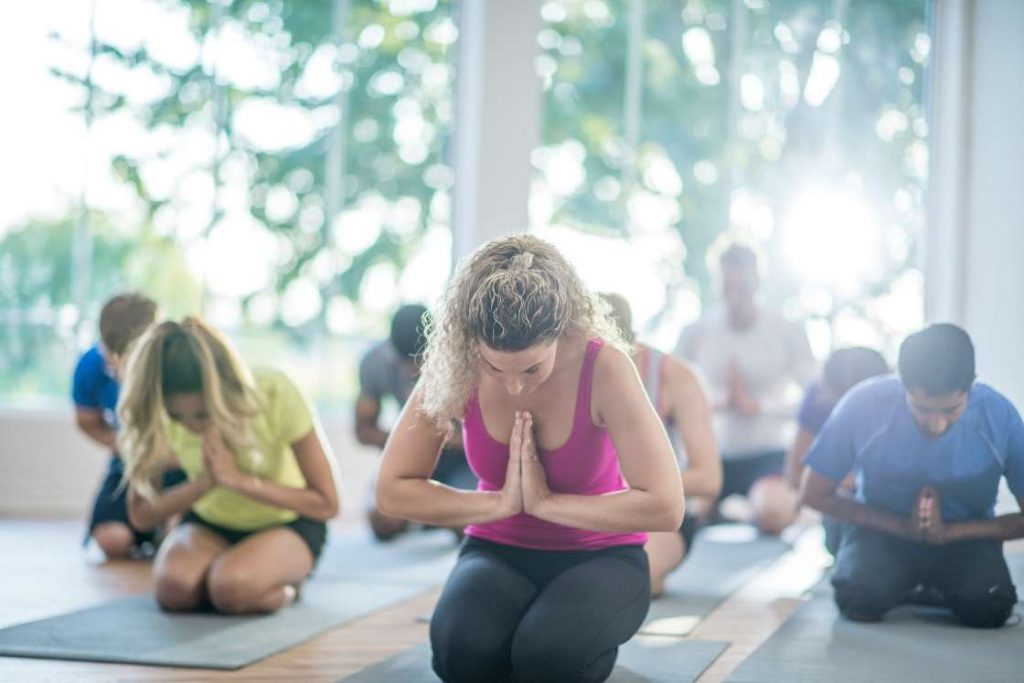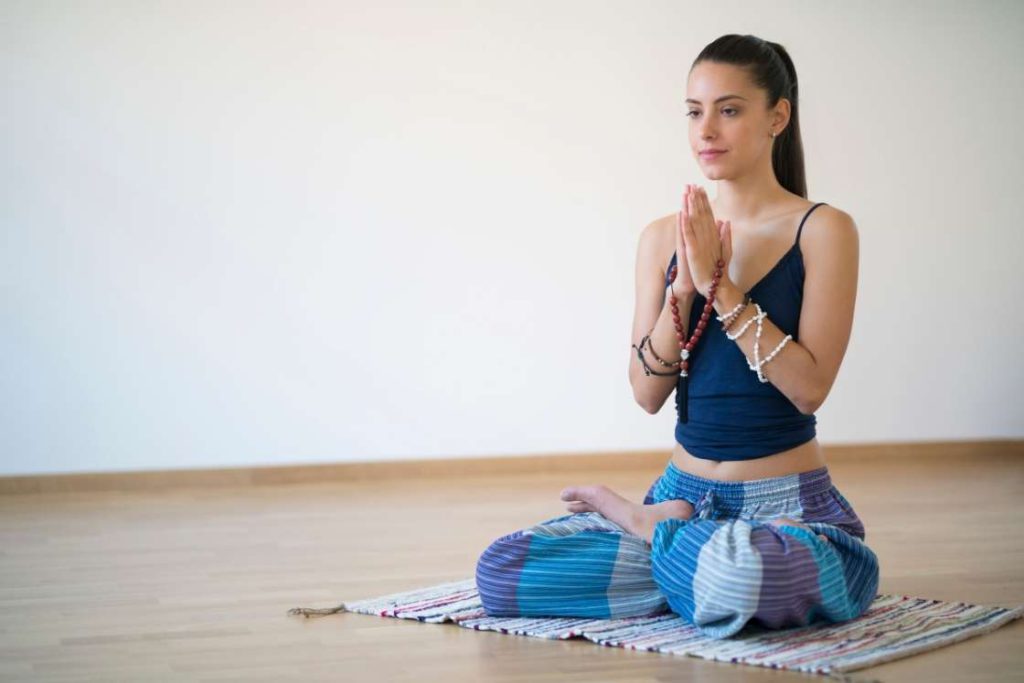Why We Say Namaste: The Meaning and Science of the Yoga Greeting
Namaste is more than just a polite greeting; it is a gesture rooted in India’s spiritual and cultural traditions. Unlike casual salutations such as “Hi” or “Hello,” Namaste carries layers of meaning, symbolising respect, humility, and the recognition of...
 The literal meaning of Namaste. Image: CanvaNamaste British English Pronunciation by Macmillan Dictionary
The literal meaning of Namaste. Image: CanvaNamaste British English Pronunciation by Macmillan DictionaryNamaste is more than just a polite greeting; it is a gesture rooted in India’s spiritual and cultural traditions. Unlike casual salutations such as “Hi” or “Hello,” Namaste carries layers of meaning, symbolising respect, humility, and the recognition of the divine essence within another person.
The practice of Namaste dates back to the Vedic period, where sages and scholars viewed it not only as a social custom but also as a mindful act connected to energy and consciousness. This simple gesture, performed by joining the palms at the heart centre, embodies a blend of science, spirituality, and holistic wisdom that continues to hold relevance today.
What does namaste means?
The word Namaste has its roots in Sanskrit, the sacred language of Hinduism. It comes from two terms: namah meaning “I bow,” and te meaning “to you.” At its most direct level, Namaste translates to “I bow to you.”
However, its meaning goes far beyond a literal bow. In the Vedic worldview, divinity is not limited to temples or deities it exists within every living being. Namaste reflects this belief. When spoken with the accompanying gesture of folded palms, the deeper sense of the word becomes:
“The divine in me bows to the divine in you.”
Over time, many translations and interpretations have been offered, each carrying the same essence of reverence and unity. Some of the most widely embraced include:
I honour the place in you that is also in me. My soul recognises your soul. I bow to the place in you that is love, light, and joy. When you and I bow to our true nature, we are one. We are the same, we are one. I honour the place in you where the entire universe dwells.Together, these meanings show that Namaste is not just a greeting; it is an acknowledgment of shared divinity and the unity of all existence.
Are namaste and namaskar the same?
 Namaskar is when when greeting a large group. Image: Canva
Namaskar is when when greeting a large group. Image: CanvaWhile Namaste is widely known, its close counterpart Namaskar (or Namaskaram in South India) is also a traditional greeting. Both come from Sanskrit and share the root namah (“to bow”), but they differ slightly in meaning and usage.
Namaste combines namah (“I bow”) with te (“to you”), and is often used in personal, one-to-one greetings. Namaskar (from namah + kara, “doing”) literally means “I offer salutations.” It is considered a more formal or collective greeting, commonly used when addressing a group or audience.In practice, the distinction is subtle. For example, an artist at a concert may open with Namaskar to greet the entire gathering, whereas Namaste is more natural in personal interactions.
Thus, while both express reverence and respect, Namaskar emphasises the act of paying salutations, and Namaste highlights the acknowledgement of the other person’s inner divinity.
 Namaste social implications. Source: Giphy
Namaste social implications. Source: GiphyMaking Namaste a part of daily life is not only a spiritual act but also a social bridge. When practiced regularly, it brings balance to thoughts, emotions, and behaviour qualities that naturally reflect in one’s personality and relationships. People often find such presence calm, respectful, and pleasant to be around.
In India, Namaste has been woven into culture for thousands of years as a gesture of respect, humility, and spiritual awareness. Its symbolism goes beyond words; the simple act of joining hands and bowing the head creates an immediate sense of harmony.
For Indian society, the gesture carries a deep cultural memory. Seeing someone greet with Namaste invokes familiarity, warmth, and acceptance. By adopting Namaste in everyday interactions, you align with a practice that makes social connections more welcoming and respectful.
Scientific significance
 Namaste means union of opposite energies. Image: Canva
Namaste means union of opposite energies. Image: CanvaAlthough Namaste is best known today for its social and cultural meaning, its roots lie deep within yogic science. The gesture itself is a mudra specifically Anjali Mudra—which plays a vital role in both yoga practice and spiritual discipline.
In Anjali Mudra, the palms are pressed together with fingers pointing upward, placed close to the chest, throat, or forehead. When combined with the respectful bow and spoken word, this becomes the gesture of Namaste. Thus, simply folding the palms is not Namaste; it is Anjali Mudra, which becomes Namaste when used as a greeting.
From a physiological perspective, our palms are rich in nerve endings and pressure points, many of which are recognised in yoga, Ayurveda, and reflexology. Pressing the palms together stimulates these points, balances energy channels, and calms the nervous system.
Yogic science also explains Namaste as the union of opposites. The human body reflects dual energies; positive and negative, yin and yang, masculine and feminine, prāna and apāna, sattva and tamas. These polarities are said to flow through the left and right sides of the body. By joining the palms, we symbolically and energetically bring these two forces into harmony, creating balance within.
This act of unity offers several benefits, including:
Improved focus and centred awareness Calming of the mind and reduction of stress Activation of subtle energy channels (nadis) A sense of inner alignment and wholenessIn this way, Namaste is not only a cultural greeting but also a scientifically rooted yogic practice designed to harmonise body, mind, and spirit.
Spiritual significance of namaste
In yogic and spiritual traditions, every form of creation is believed to emerge from a single universal source where all forces unite. A trace of these forces exists within every being as different energies. The essence of spirituality is to harmonise these energies and reconnect with that supreme source.
This source, however, cannot be perceived directly through ordinary senses. It is experienced through inner alignment when we balance and channel our internal energies into harmony, we begin to feel the presence of that universal truth.
The gesture of Namaste, performed with Anjali Mudra, is regarded as a powerful tool for this alignment. By joining the palms at the heart centre, we symbolically unite the dual forces within us and offer them to the higher source. This act cultivates humility, surrender, and a sense of oneness with creation.
Because of this, Namaste is not only a social greeting but also a spiritual practice. Yogic texts and traditions recommend it as a means of centring the self, invoking inner peace, and deepening the journey toward self-realisation.
When it is used in yoga?
 Namaste in yoga. Source: Yoga Peace GIF By Adidas Giphy
Namaste in yoga. Source: Yoga Peace GIF By Adidas GiphyAmong yogis, Namaste is one of the most commonly used Sanskrit words, symbolising respect, gratitude, and unity. In yoga classes, it is typically used at both the beginning and the end of a session.
At the beginning of class – When the instructor arrives, they often greet the students with Namaste before chanting the opening prayer or mantra. Students may also exchange Namaste with each other as a humble way of beginning their practice together. At the end of class – After Śavāsana (final relaxation), practitioners rub their palms gently and bring them together at the heart or forehead centre in Namaste. This closing gesture honours the energy cultivated during practice and acknowledges the teacher, fellow students, and the inner self.In this way, Namaste bookends the yoga session inviting mindfulness at the start and sealing the practice with gratitude and harmony at the end.
In asanas practice
Namaste as Anjali Mudra is very often used in different asanas and meditation practices during a yoga session. You can practice the Namaste while in any sitting posture or standing in Tadasana, Vrikshasana, Ardha Matsyendrasana or Vajrasana. These are just a few examples but you can practice Namaste in any pose, that keeps your hands free.
At the beginning: Every yoga pose has a particular physical and mental requirement. The namaste mudra brings the energies of your body in harmony, which prepares your muscles and nerves for the tension they are about to face. The Namaste pose with deep breathing before a posture will help enhance your blood flow, increase oxygen intake and stimulate your neural pathways. Practically, warming up your body for the pose. During the hold: During any hold of a pose, Namaste triggers and stimulates a lot of biological benefits for different specific body organs and muscle groups. During the pose hold, the Namaste mudra will open up the concerned energy gateways and regulate an unfettered flow of energy. At the end: Practicing Namaste Mudra at the end of a yoga pose is particularly effective in normalizing your mind and body. Each pose creates turbulence of energies in your body. Which further leads to the disruption of normal flow, to mechanisms like blood flow, hormonal activities, lymphatic movements, and so on. The Namaste mudra after a pose relaxes your body, by harmonizing the turbulent energies and restoring all bodily mechanisms to their regular pace.The correct way of doing namaste
The Namaste gesture may appear simple, but its effectiveness lies in the precise placement of the hands and posture. Different cultures and yogic traditions may show slight variations, but these are intentional and systematic. Here’s how to perform Namaste correctly at different levels:
Namaste in front of your forehead: Raise your hands to the height of your forehead, and join the palms of your hands, right in front of your forehead. Keep your elbow joints at the height of your shoulders. Don’t press your palms hard, but gently keep them held against each other. Do keep any space between your fingers, and keep them straight pointed upward. The middle of our palms have a slight depression, and this region will create a gap within the join of your hands. Maintain this gap. Namaste in front of your throat: For this Namaste, everything remains the same from the previous instructions, except your hands come down in front of your throat. And your elbow joints come down to the level of your chest. Namaste in front of your chest: Once again all instructions remain the same, except your hands come down in front of your breastbone and your elbow joints come down to the level of your abdomen. In this gesture, alternatively, you can keep your elbows parallel to the ground by maintaining your elbow joints at your chest level.What changes will namaste bring to your life?

The practice of Namaste brings many physical, mental, emotional, and personality changes. Rest assured these changes will prove to be positive and beneficial in your life. Although you must not expect any overnight changes. Mudras make many subtle energy tweaks all over your body, that over time build up to draw prominent changes. So you must be patient and dedicated.
1. Namaste harnesses the power of awareness
When you perform Namaste in front of your forehead, you consequently flood your third eye or the pineal chakra with harmonious energy flow. Your pineal gland plays an elemental role in awareness, concentration, perception, and cognition. Namaste gesture ensures that there is an unobstructed and harmonious energy flow in your neural pathways. With regular practice of Namaste, you could realize that this is a gesture that harnesses the power of awareness.
2. Namaste enhances the ability to communicate
When you perform Namaste in front of your throat, you activate your throat chakra. The chakra is responsible for your vocal communication. Namaste gestures improve the energy flow to your vocal apparatuses, muscles, and nerves. The gesture will also help you develop the concentration needed to form your thoughts and the intellect to convert them into words. When the namaste is performed in front of the throat, while sitting in an easy pose, and chanting Om, it can help you cure infections and disorders related to the Ear, Nose, and Throat region. It will also give you great control over your vocal muscles, as such, over your voice and tone.
3. Namaste for a better cardiovascular and respiratory function
Practicing Namaste pose in front of the breastbone activates the Anahata chakra. When you practice the Namaste pose in front of your breastbone, while standing in the mountain pose or tree pose, it has the potential to improve your blood flow. An improved blood flow can cure a long list of cardiovascular disorders, and as such, improve your cardiovascular functions in general. On another hand, when you sit in an easy pose, take deep breaths and perform the Namaste gesture in front of your chest, it improves the oxygen management in your lungs.
4. Namaste is the go-to gesture for spirituality
When you practice the Kailash mudra variant of the Anjali mudra, it will stimulate your crown chakra. Your crown chakra is your gateway to the universal energies outside your physical existence. This gesture is a highly meditative gesture, that will help you enter a state of samadhi, or total absorption.
5. Namaste balances your polar extremes
The very basic concept of Namaste is to bring balance to the opposite energies in your body. Namaste, all of its variants, will effectively help you attain a balance between the feminine and masculine energies within you. If your emotion is a feminine energy, your logic is masculine. And in every situation of life you will need equal measures of both logic and emotion.
Another similar example is the balance of imagination and discipline, where imagination is a feminine force and discipline is masculine. And as it happens for any creation, you will need a fair amount of both imagination and discipline. Namaste will help you succeed in different spheres of life by establishing a balance between your feminine and masculine energies.
Conclusion
In everyday life, Namaste is most often used as a respectful greeting. It conveys politeness and humility when meeting strangers, friends, or acquaintances. Beyond this social role, the gesture also carries deep meaning within yogic traditions and spiritual practices, where it is used to centre the self and honour the divine in others.
In Indian culture, Namaste is also a gesture of gratitude and reverence commonly offered to elders, teachers, and mentors. It can further express sincerity when making a request, reflecting honesty in one’s intentions.
Thus, Namaste is more than a simple salutation. Whether used in daily interactions, in yoga practice, or in spiritual rituals, it symbolises respect, humility, and the recognition of shared divinity.

 ValVades
ValVades 








.png?trim=0,0,0,0&width=1200&height=800&crop=1200:800)





















